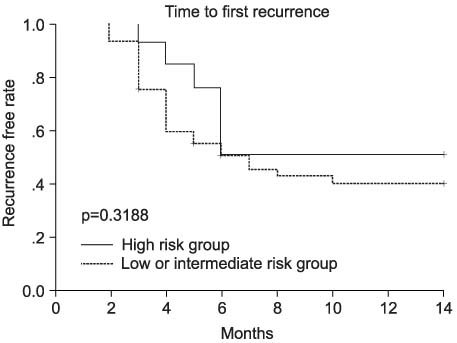Korean J Urol.
2006 Aug;47(8):824-828. 10.4111/kju.2006.47.8.824.
Safety and Efficacy of Intravesical Keyhole-Limpet Hemocyanin Therapy for Superficial Transitional Cell Carcinoma: A Prospective, Multicenter Study
- Affiliations
-
- 1Department of Urology, College of Medicine, Catholic University of Korea, Seoul, Korea. yms4558@catholic.ac.kr
- 2Department of Urology, Sam Anyang Hospital, Anyang, Asan Medical Center, Korea.
- 3Department of Urology, University of Ulsan College of Medicine, Korea.
- 4Department of Urology, Seoul National University College of Medicine, Korea.
- 5Department of Urology, Yonsei University College of Medicine, Korea.
- 6Department of Urology, Samsung Medical Center, Sungkyunkwan University School of Medicine, Seoul, Korea.
- KMID: 2294109
- DOI: http://doi.org/10.4111/kju.2006.47.8.824
Abstract
-
PURPOSE: We wanted to determine the safety and efficacy 1 year after intravesical keyhole-limpet hemocyanin (KLH) therapy for the patients suffering with superficial transitional cell carcinoma.
MATERIALS AND METHODS
A total of 60 patients with bladder cancer who had undergone transurethral resection were treated with a one-year protocol (once a week for 6 weeks and 12 further treatments every 4 weeks) of KLH 20mg. The local and systemic safety and efficacy were evaluated.
RESULTS
In terms of the safety of KLH, 4 patients (6.7%) reported dizziness and slight fever, and 2 (3.3%) experienced urgency. The remaining 54 patients (90.0%) did not report any local side effects during the treatment period. In terms of efficacy, recurrence developed in 32 patients (53.3%) at a mean of 4.5 months after transurethral resection; 28 patients (46.7%) were disease free after 14 months. The univariate analysis showed a greater level of efficacy in the patients suffering with bacille Calmette-Gu rin (BCG)-refractory disease (p=0.0150). No significant differences were found between the low, the intermediate-risk and the high-risk patients in terms of efficacy.
CONCLUSIONS
The results of this study have confirmed the good tolerability of intravesical KLH and better efficacy in the BCG-refractory patients. However, in terms of overall efficacy, intravesical KLH therapy had no superiority over that of other intravesical treatments in terms of the overall efficacy.
MeSH Terms
Figure
Reference
-
1. Duque JL, Loughlin KR. An overview of the treatment of superficial bladder cancer. Intravesical chemotherapy. Urol Clin North Am. 2000. 27:125–135.2. Morales A, Eidinger D, Bruce AW. Intracavitary Bacillus Calmette-Guérin in the treatment of superficial bladder tumors. J Urol. 1976. 116:180–183.3. Lamm DL, van der Meijden PM, Morales A, Brosman SA, Catalona WJ, Herr HW, et al. Incidence and treatment of complications of bacillus Calmette-Guérin intravesical therapy in superficial bladder cancer. J Urol. 1992. 147:596–600.4. Perabo FG, Muller SC. Current and new strategies in immunotherapy for superficial bladder cancer. Urology. 2004. 64:409–421.5. Oosterlinck W, Lobel B, Jakse G, Malmstrom PU, Stockle M, Sternberg C, et al. Guidelines on bladder cancer. Eur Urol. 2002. 41:105–112.6. Herr HW, Dalbagni G. Defining bacillus Calmette-Guérin refractory superficial bladder tumors. J Urol. 2003. 169:1706–1708.7. Olsson CA, Chute R, Rao CN. Immunologic reduction of bladder cancer recurrence rate. J Urol. 1974. 111:173–176.8. Jurincic CD, Engelmann U, Gasch J, Klippel KF. Immunotherapy in bladder cancer with keyhole-limpet hemocyanin: a randomized study. J Urol. 1988. 139:723–726.9. Jurincic-Winkler CD, Metz KA, Beuth J, Klippel KF. Keyhole limpet hemocyanin for carcinoma in situ of the bladder: a long-term follow-up study. Eur Urol. 2000. 37:Suppl 3. 45–49.10. Lamm DL, Dehaven JI, Riggs DR. Keyhole limpet hemocyanin immunotherapy of bladder cancer: laboratory and clinical studies. Eur Urol. 2000. 37:Suppl 3. 41–44.11. Flamm J, Donner G, Bucher A, Holtl W, Albrecht W, Havelec L. Topical immunotherapy (KLH) vs. chemotherapy (Ethoglucid) in prevention of recurrence of superficial bladder cancer. A prospective randomized study. Urologe A. 1994. 33:138–143.12. Kalble T, Mohring K, Ikinger U, Riedasch G, Staehler G. Intravesical prevention of recurrence of superficial urinary bladder cancer with BCG and KLH. A prospective randomized study. Urologe A. 1991. 30:118–121.13. Joudi FN, O'Donnell MA. Second-line intravesical therapy versus cystectomy for bacille Calmette-Guérin (BCG) failures. Curr Opin Urol. 2004. 14:271–275.14. Lam JS, Benson MC, O'Donnell MA, Sawczuk A, Gavazzi A, Wechsler MH, et al. Bacillus Calmette-Guérin plus interferon-alpha2B intravesical therapy maintains an extended treatment plan for superficial bladder cancer with minimal toxicity. Urol Oncol. 2003. 21:354–360.15. Dalbagni G, Russo P, Sheinfeld J, Mazumdar M, Tong W, Rabbani F, et al. Phase I trial of intravesical gemcitabine in bacillus Calmette-Guérin-refractory transitional-cell carcinoma of the bladder. J Clin Oncol. 2002. 20:3193–3198.16. Dalbagni G, Mazumdar M, Russo P, Sheinfeld J, Donat SM, Bochner BH, et al. Phase II trial of intravesical gemcitabine in BCG-refractory transitional cell carcinoma of the bladder. J Urol. 2004. 171:Suppl. 72. abstract 274.
- Full Text Links
- Actions
-
Cited
- CITED
-
- Close
- Share
- Similar articles
-
- Intravesical Chemotherpy in Superficial Transitional Cell Carcinoma of the Bladder Preliminary Report
- Antitumor Activity of Keyhole Limpet Hemocyanin on N-butyl-N-(4-hydroxybutyl) Nitrosamine Induced Bladder Carcinoma in Mice
- Intravesical Chemotherapy in Superficial Bladder Tumor: Preliminary Report
- BCG(Bacillus Calmette-Guerin) for Superficial Transitional Cell Carcinoma of the Bladder
- Ureteral Obstruction Caused by Periureteral Tuberculous Granuloma after Intravesical BCG Therapy for Superficial Bladder Tumors



